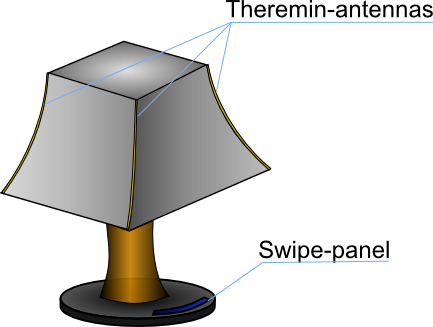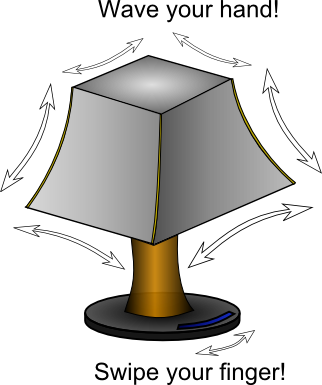

Our assignment for this week was to:
Projects can be separate or joint, but need to show individual mastery of all of the skills where possible, we should make rather than buy the parts of our project.
More information about this week assignment in general can be found here.
There were some changes to my final project idea during my education at FabAcademy (you may trace the evolution here).
Now the idea is to make a smart lamp that will enhance the user experience and allow to customise the very surroundings by simple and intuitive interfaces: touch-interface gestures-recognition (Theremin-alike).
Here are the sketches of how would I like it to look like and what gestures I would like to make it understand:

|

|
There will be a lot of RGB LEDs inside the lamp and using the gestures discribed will allow to change the illumination power and colour. I also want to give to the user the freedom to adjust the controls (some system conditions are to get the commands from the user, some are to reprogramm the gestures from the user. To make the well usable algorythm isn't easy, but it's quite a goal!).
The very idea of this project was inspired by the the very first electronic musical instrument - theremin. In this instrument you have two antennas that worc like capacitors together with your hand. The closer your hand is, the larger is capacity and thus you can modulate the frequensy and amplitude for the sound using two antennas and two hands.
There were many DIY touch sensors made by enthusiasts all over the world; there also were some experiments with gestures based on the optic sensors, but my brief research gave no result about such volume sensors that would allow you to controll the light just by wawing your hands around.
I need couple days more to finish the list of materials, but what's clear to me, is that I will need some optrons like TCRT500 for the swipe-panel. It also takes some mosphets, capacitors and high-nominal (10M) resistors to make the theremin-like antenna, but for now I'm still analysing the schematics and don't know the values.
If there will be no materials in our local lab inventory, I'll get them from local electronic shops. There are a lot of them in Moscow and I will place the comparation on prices here a little later. It will also be really simple to purchase any parts that are not in inventory, because my main goal is to make this system as easy and affordable as possiple on hardware side.
Brief research shows that the budjet is far below $100, because I would like to fabricate as many parts for this lamp as it's possible. Check it out: The skeleton for the lamp can be done even from cardboard (look at the google glasses! The point is not what you make it from, but what impact you do!); microcontroller board (fabkit-alike) costs below $20; ell the things needed above that will be some mosphets, resostors and capacitos. It makes the final price really low. I would also like to provide my project with alternative description for TCRT5000 (in fact it is only a coupled IR-phototransistor and IR-LED).
Here are the systems that are to be made to finish this project:
At least: PCB fabrication, laser cutting (if using cardboard, acrilyc or thin plywood for skeleton) or shopbot-cutting (if using thick plywood); making compisites for the lamp body baybe. For now the technological requirements are minimalistic.
Find out more about thereminVox is the most challenging one! But still I need to make all the separate systems for this project and combine them, but not earlier than making it all on the single controller!
How exactly to solve the conflict between the modularity and price I propose?
This subject is under construction yet, but still I would like to collect all the data about antenna by 28-th and 29-th is the dead-line for my prototype of swipe-panel and RGB-LED pannel!
If I can fit all the limitations I commited above during further developement, it will be good. If the whole thing will be more than just a creepy LED-toy, but will allow me or some other people to make a step forward in customising their surroundings and thus to improve their productivity or life satisfaction, it will be even better. But the most reasonable evaluation will be the demand for this thing - if it will be any :)
Back to my main page